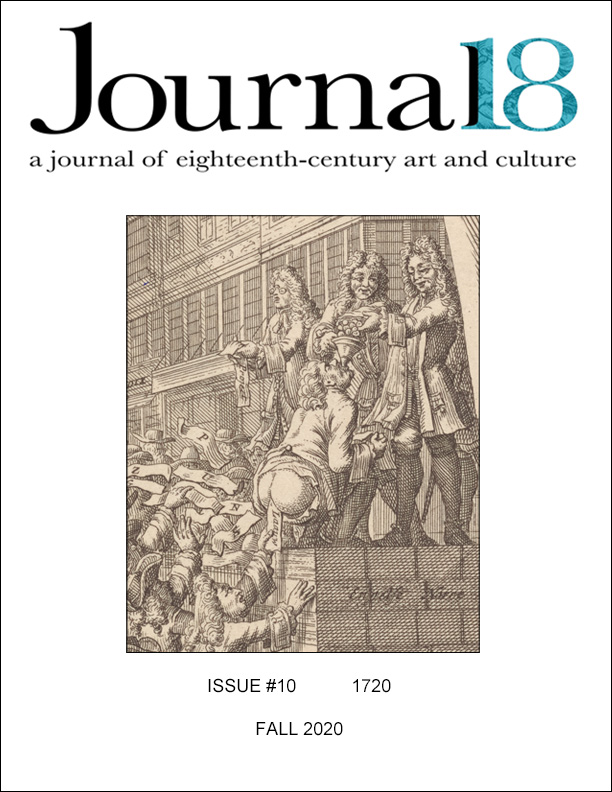
Paris, 1720. Throngs of frenzied speculators gather on rue Quincampoix, seduced by the promise of spectacular wealth awaiting investors in the Compagnie des Indes. The manic trade in stock shares fuels an unprecedented bull market that culminates in the world’s first international financial disaster: the collapse of the Mississippi and South Sea Bubbles, named after the state-sponsored, New World trading companies in France and England, respectively, that ignited the speculation craze. The calamities will live on in popular imaginations as inaugurating the boom-and-bust cycles of the modern economy. Anonymous Dutch prints compiled in a volume known as Het groote tafereel der dwaashied (“The Great Mirror of Folly,” or the Tafereel) will immortalize the bubbles as lessons in the dangers of herd behavior. In the example shown on this issue’s cover, John Law—controller-general of France’s finances, mastermind of the Mississippi scheme, and recent convert to Catholicism—squats on a pedestal while three priest-like charlatans cram a funnel filled with coins into his open mouth, prompting him to defecate a bill bearing his own name into the hands of an overeager speculator. The print lampoons not only Law but also the worshipful hordes who foolishly invested belief in his filthy lucre, empty paper promises emblematic of what satirists dubbed “a commerce in wind.”
Such caricatures have long dominated visual accounts of 1720—until now. This issue of Journal18 reconsiders that watershed year not only through satirical depictions but also through the lens of art objects that, far from critiquing the delusions and desires unleashed by New World commerce, actively encouraged them. Taking part in a tricentenary reevaluation of the significance of the bubbles—one that includes a special issue of the journal Eighteenth-Century Studies; a workshop on “Panic and Plague in 1720 and 2020” organized by the Center for Early Modern History at the University of Minnesota; and a forthcoming exhibition on “Fortune and Folly in 1720” at The New York Public Library–the four articles comprising this issue explore how artworks made around 1720 alternatively proselytized on behalf of bubble ventures, and promoted ideologies and activities that supported colonial commerce.
Investigating the pocket globes designed by the London cartographer, engraver, and publisher Herman Moll, Jason Nguyen argues that such commodities effectively marketed slave-labor backed practices of global capitalism to a broadening consumer base. Examining the role of cartographic practice and prints alike in mythologizing the promise of New World commerce, Camille Mathieu spotlights the ways in which maps of La Louisiane—and particularly their cartouches—substituted utopian visions of readily-extractable mineral wealth for realities of forced, Indigenous labor. William N. Goetzmann and Darius A. Spieth explore how Giovanni Antonio Pellegrini’s allegorical ceiling painting for Paris’s Banque Royale attempted to visualize and endorse Law’s vision of global commercial hegemony–in part by drawing upon royal precedents that were subsequently ridiculed in the Tafereel. Pellegrini’s depiction of the “diverse nations of the world” may have helped inspire the artist’s sister-in-law and travel companion in Paris, Rosalba Carriera, to create her own much more intimate version of the Four Continents in pastel. In his contribution, Oliver Wunsch offers a nuanced reading of Carriera’s images, complicating a standard view of how artistic renderings of skin color contributed to emerging ideas of racial difference.
It is our hope that these discussions, spanning multiple media and geographies, will contribute to new understandings not only of the seminal impact of 1720 over the course of the long eighteenth century, but also of its critical relevance to our current moment.
Issue Editors
Nina Dubin, University of Illinois at Chicago
Meredith Martin, NYU and Institute of Fine Arts, New York
ARTICLES
Handheld Cartography: Herman Moll’s Pocket Globes and Speculative Capital in the 1710s
Jason Nguyen
An Effortless Empire: John Law and the Imagery of French Louisiana, 1683-1735
Camille Mathieu
The Banque Royale Ceiling and the Imagery of Finance in the Age of Absolutism
William N. Goetzmann and Darius A. Spieth
Rosalba Carriera’s Four Continents and the Commerce of Skin
Oliver Wunsch
Cover image: Harlequin the Stockjobber (detail), 1720. Etching and engraving, 36 x 25.3 cm. Print Collection, The Miriam and Ira D. Wallach Division of Art, Prints and Photographs, The New York Public Library, Astor, Lenox and Tilden Foundations.
